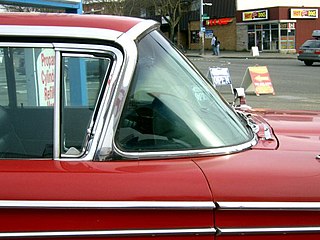
The windshield or windscreen of an aircraft, car, bus, motorbike, truck, train, boat or streetcar is the front window, which provides visibility while protecting occupants from the elements. Modern windshields are generally made of laminated safety glass, a type of treated glass, which consists of, typically, two curved sheets of glass with a plastic layer laminated between them for safety, and bonded into the window frame.

A bumper is a structure attached to or integrated with the front and rear ends of a motor vehicle, to absorb impact in a minor collision, ideally minimizing repair costs. Stiff metal bumpers appeared on automobiles as early as 1904 that had a mainly ornamental function. Numerous developments, improvements in materials and technologies, as well as greater focus on functionality for protecting vehicle components and improving safety have changed bumpers over the years. Bumpers ideally minimize height mismatches between vehicles and protect pedestrians from injury. Regulatory measures have been enacted to reduce vehicle repair costs and, more recently, impact on pedestrians.

Auto detailing is an activity that keeps the vehicle in its best possible condition, primarily cosmetic, as opposed to mechanical. Detailing is achieved by removing visible and invisible contaminants from the vehicle's interior and polishing the exterior to its original blemish-free finish. The fundamental detail options include an exterior wash and wax, interior vacuuming, window cleaning, and surface polishing.

A fuel tank is a safe container for flammable fluids, often gasoline or diesel fuel. Though any storage tank for fuel may be so called, the term is typically applied to part of an engine system in which the fuel is stored and propelled or released into an engine. Fuel tanks range in size and complexity from the small plastic tank of a butane lighter to the multi-chambered cryogenic Space Shuttle external tank.
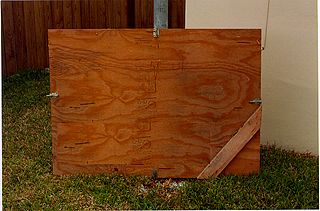
Hurricane coverings, commonly known as shutters, are used in hurricane mitigation to protect houses and other structures from damage caused by storms. Hurricane shutters are used to prevent windows from being broken by flying objects during a storm. Although the negative pressure caused by high-speed wind flowing over a building roof can cause the roof to fail with the building envelope intact, broken windows allow the air pressure to rise inside a building, creating an even greater pressure difference and increasing the likelihood of roof failure.

Military vehicles are commonly armoured to withstand the impact of shrapnel, bullets, shells, rockets, and missiles, protecting the personnel inside from enemy fire. Such vehicles include armoured fighting vehicles like tanks, aircraft, and ships.

A bollard is a sturdy, short, vertical post. The term originally referred to a post on a ship or quay used principally for mooring boats. It now also refers to posts installed to control road traffic and posts designed to prevent automotive vehicles from colliding or crashing into pedestrians and structures.

Saltillo tile is a type of terracotta tile that originates in Saltillo, Coahuila, Mexico. It is one of the two most famous products of the city, the other being multicolored woven sarapes typical of the region. Saltillo-type tiles are now manufactured at many places in Mexico, and high-fire "Saltillo look" tiles, many from Italy, compete with the terracotta originals.
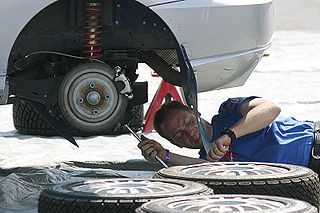
An auto mechanic is a mechanic who services and repairs automobiles, sometimes specializing in one or more automobile brands or sometimes working with any brand. In fixing cars, their main role is to diagnose and repair the problem accurately and quickly. Seasoned auto repair shops start with a (Digital) Inspection to determine the vehicle conditions, independent of the customers concern. Based on the concern, the inspection results and preventative maintenance needs, the mechanic/technician returns the findings to the service advisor who then gets approval for any or all of the proposed work. The approved work will be assigned to the mechanic on a work order. Their work may involve the repair of a specific part or the replacement of one or more parts as assemblies. Basic vehicle maintenance is a fundamental part of a mechanic's work in modern industrialized countries, while in others they are only consulted when a vehicle is already showing signs of malfunction.

Rustproofing is the prevention or delay of rusting of iron and steel objects, or the permanent protection against corrosion. Typically, the protection is achieved by a process of surface finishing or treatment. Depending on mechanical wear or environmental conditions, the degradation may not be stopped completely, unless the process is periodically repeated. The term is particularly used in the automobile industry.

Windshield washer fluid is a fluid for motor vehicles that is used in cleaning the windshield with the windshield wiper while the vehicle is being driven.

A flat tire is a deflated pneumatic tire, which can cause the rim of the wheel to ride on the tire tread or the ground potentially resulting in loss of control of the vehicle or irreparable damage to the tire. The most common cause of a flat tire is puncturing of the tire by a sharp object, such as a nail or pin, letting the air escape. Depending on the size of the puncture, the tire may deflate slowly or rapidly.

Ziebart International Corporation is a privately owned corporation based in Troy, Michigan, and is the worldwide franchisor of the Ziebart brand of automotive aftermarket stores.

A window deflector is mounted above the doors of some automobiles, to protect the inside of the car from rain or other precipitation in case of slightly opened windows. Deflectors may also be fitted to sunroofs to change the flow of air.
Headlight restoration or plastic headlight restoration is the act of restoring aged headlight lenses that have become discolored or dull due the original factory UV protective coating degrading primarily due to UV light and other environmental factors such as road debris impact rain, and exposure to caustic chemicals. Over time the factory protective hardcoat breaks down with UV degradation and wear from abrasion, etc. If left untreated the polycarbonate lens will eventually develop small surface cracks, a condition referred to as crazing. Also, the polycarbonate lens will eventually discolor through the thickness of the lens, The effectiveness of the headlight in terms of light output measured in lux can be significantly reduced. This condition which results in hazy and discoloured lenses is known for causing reduced night time visibility for drivers as the condition becomes worse. It is possible for cloudy and hazy headlights to be restored to a like-new condition and represents typically a far more economical alternative than replacing the lens.
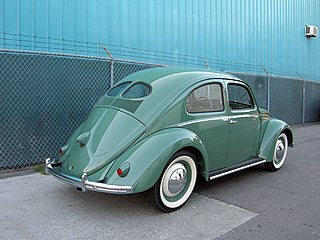
Conservation and restoration of road vehicles is the process of restoring a vehicle back to its original working condition. Vehicles, whether partially scrapped or completely totaled, are typically restored to maintain their roadworthiness or to preserve those with antique status for use as showpieces.
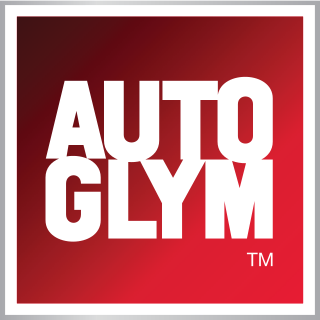
Autoglym is a British manufacturer of a range of car care and valeting products, which are sold in over 45 countries.
Paintless dent repair (PDR), also known as paintless dent removal, describes a method of removing small dents, dings, and minor collision damage dents from the body of a motor vehicle. A wide range of damage can be repaired using paintless dent repair as long as the paint surface is intact. Paintless dent repair may be used on both aluminum and steel panels.

A vehicle vinyl wrap is the automotive aftermarket practice of completely or partially covering a vehicle's original paint with a vinyl wrap. Generally this vinyl wrap will be a different color or finish like a gloss, matte or clear protective layer.

















